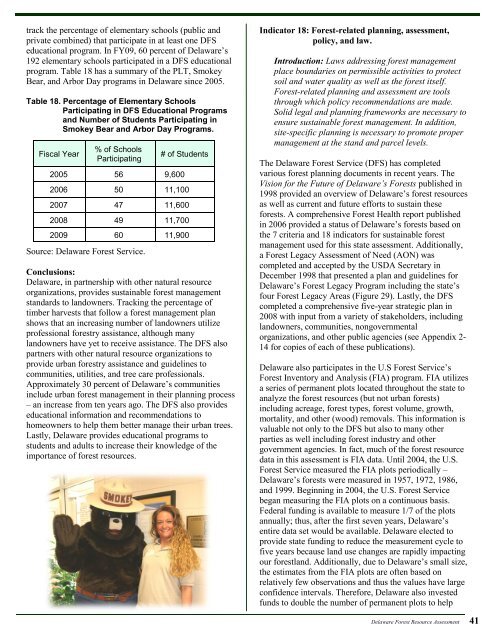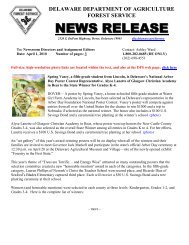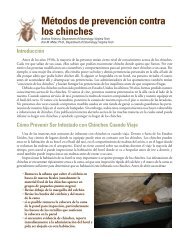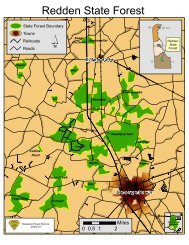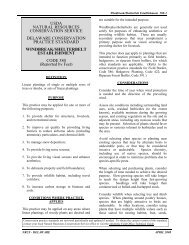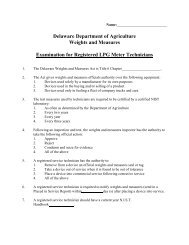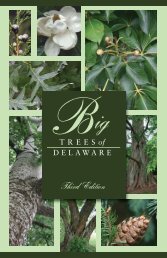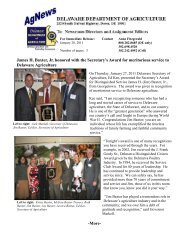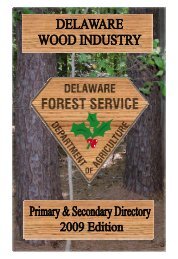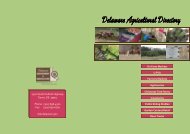DFS Resource Assessment - Delaware Department of Agriculture
DFS Resource Assessment - Delaware Department of Agriculture
DFS Resource Assessment - Delaware Department of Agriculture
Create successful ePaper yourself
Turn your PDF publications into a flip-book with our unique Google optimized e-Paper software.
track the percentage <strong>of</strong> elementary schools (public and<br />
private combined) that participate in at least one <strong>DFS</strong><br />
educational program. In FY09, 60 percent <strong>of</strong> <strong>Delaware</strong>’s<br />
192 elementary schools participated in a <strong>DFS</strong> educational<br />
program. Table 18 has a summary <strong>of</strong> the PLT, Smokey<br />
Bear, and Arbor Day programs in <strong>Delaware</strong> since 2005.<br />
Table 18. Percentage <strong>of</strong> Elementary Schools<br />
Participating in <strong>DFS</strong> Educational Programs<br />
and Number <strong>of</strong> Students Participating in<br />
Smokey Bear and Arbor Day Programs.<br />
Fiscal Year<br />
% <strong>of</strong> Schools<br />
Participating<br />
Source: <strong>Delaware</strong> Forest Service.<br />
# <strong>of</strong> Students<br />
2005 56 9,600<br />
2006 50 11,100<br />
2007 47 11,600<br />
2008 49 11,700<br />
2009 60 11,900<br />
Conclusions:<br />
<strong>Delaware</strong>, in partnership with other natural resource<br />
organizations, provides sustainable forest management<br />
standards to landowners. Tracking the percentage <strong>of</strong><br />
timber harvests that follow a forest management plan<br />
shows that an increasing number <strong>of</strong> landowners utilize<br />
pr<strong>of</strong>essional forestry assistance, although many<br />
landowners have yet to receive assistance. The <strong>DFS</strong> also<br />
partners with other natural resource organizations to<br />
provide urban forestry assistance and guidelines to<br />
communities, utilities, and tree care pr<strong>of</strong>essionals.<br />
Approximately 30 percent <strong>of</strong> <strong>Delaware</strong>’s communities<br />
include urban forest management in their planning process<br />
– an increase from ten years ago. The <strong>DFS</strong> also provides<br />
educational information and recommendations to<br />
homeowners to help them better manage their urban trees.<br />
Lastly, <strong>Delaware</strong> provides educational programs to<br />
students and adults to increase their knowledge <strong>of</strong> the<br />
importance <strong>of</strong> forest resources.<br />
Indicator 18: Forest-related planning, assessment,<br />
policy, and law.<br />
Introduction: Laws addressing forest management<br />
place boundaries on permissible activities to protect<br />
soil and water quality as well as the forest itself.<br />
Forest-related planning and assessment are tools<br />
through which policy recommendations are made.<br />
Solid legal and planning frameworks are necessary to<br />
ensure sustainable forest management. In addition,<br />
site-specific planning is necessary to promote proper<br />
management at the stand and parcel levels.<br />
The <strong>Delaware</strong> Forest Service (<strong>DFS</strong>) has completed<br />
various forest planning documents in recent years. The<br />
Vision for the Future <strong>of</strong> <strong>Delaware</strong>’s Forests published in<br />
1998 provided an overview <strong>of</strong> <strong>Delaware</strong>’s forest resources<br />
as well as current and future efforts to sustain these<br />
forests. A comprehensive Forest Health report published<br />
in 2006 provided a status <strong>of</strong> <strong>Delaware</strong>’s forests based on<br />
the 7 criteria and 18 indicators for sustainable forest<br />
management used for this state assessment. Additionally,<br />
a Forest Legacy <strong>Assessment</strong> <strong>of</strong> Need (AON) was<br />
completed and accepted by the USDA Secretary in<br />
December 1998 that presented a plan and guidelines for<br />
<strong>Delaware</strong>’s Forest Legacy Program including the state’s<br />
four Forest Legacy Areas (Figure 29). Lastly, the <strong>DFS</strong><br />
completed a comprehensive five-year strategic plan in<br />
2008 with input from a variety <strong>of</strong> stakeholders, including<br />
landowners, communities, nongovernmental<br />
organizations, and other public agencies (see Appendix 2-<br />
14 for copies <strong>of</strong> each <strong>of</strong> these publications).<br />
<strong>Delaware</strong> also participates in the U.S Forest Service’s<br />
Forest Inventory and Analysis (FIA) program. FIA utilizes<br />
a series <strong>of</strong> permanent plots located throughout the state to<br />
analyze the forest resources (but not urban forests)<br />
including acreage, forest types, forest volume, growth,<br />
mortality, and other (wood) removals. This information is<br />
valuable not only to the <strong>DFS</strong> but also to many other<br />
parties as well including forest industry and other<br />
government agencies. In fact, much <strong>of</strong> the forest resource<br />
data in this assessment is FIA data. Until 2004, the U.S.<br />
Forest Service measured the FIA plots periodically –<br />
<strong>Delaware</strong>’s forests were measured in 1957, 1972, 1986,<br />
and 1999. Beginning in 2004, the U.S. Forest Service<br />
began measuring the FIA plots on a continuous basis.<br />
Federal funding is available to measure 1/7 <strong>of</strong> the plots<br />
annually; thus, after the first seven years, <strong>Delaware</strong>’s<br />
entire data set would be available. <strong>Delaware</strong> elected to<br />
provide state funding to reduce the measurement cycle to<br />
five years because land use changes are rapidly impacting<br />
our forestland. Additionally, due to <strong>Delaware</strong>’s small size,<br />
the estimates from the FIA plots are <strong>of</strong>ten based on<br />
relatively few observations and thus the values have large<br />
confidence intervals. Therefore, <strong>Delaware</strong> also invested<br />
funds to double the number <strong>of</strong> permanent plots to help<br />
<strong>Delaware</strong> Forest <strong>Resource</strong> <strong>Assessment</strong> 41


